Organization
The smallest Chambers
might have as few as ten members. Membership in one of the larger
societies could number to a hundred or more. The Chambers were
predominantly an urban phenomenon. Usually members of the
societies were merchants, professionals, or the more affluent
members of the artisan class.
| Each society elected a
"Keiser" or Prince. Typically, this
person was a well to do citizen chosen for administrative
rather than creative abilities. Sometime the title was
purely honorary. Noblemen often lent their patronage to
Chambers. Like professional guilds, Chambers also named
elders and deacons. These officers fulfilled much the
same functions as those of the guild officers by the same
names. |
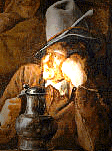 |
 |
|
Perhaps the most important member of a
Chamber was its factor. The person chosen as factor was what we in
contemporary terms might call the artistic director of
the society. The factor in charge of all literary
activities, wrote plays or poems for performances, served
as director for the public performances, and seemed to
serve as teacher/critic to the membership as they not
only performed in public but learned to write poems,
plays, and songs of their own. |
A contract dated 1524 detailed the duties and
salary of Jan Salomon, factor of the Antwerp Chamber "Den
Goudbloem". He received a yearly salary of 30 shillings. In
addition to this, he was paid one half shilling for every 100
lines of play script which he composed and 12 groten Barbants for
his services on special occasions. Although records usually fail
to record an author for Rederyker plays, the terms of this
contract seem to indicate that the factor was expected to take
the artistic lead in the society, both in terms of producing
productions and providing performance-worthy material.
| Chambers also had a designated costume
manager, standard bearer and fool. Fools were
performers who played a principal part in the farces and
amused the people at times of public processions and
royal entries. A good Fool was therefore an indispensable
element of each Chamber. |
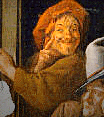 |
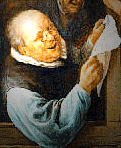 |
|
Standard bearers were responsible for
the display and maintenance of the Chamber's standard.
Every Chamber had a standard with a blazon (often a
flower) and a motto. Chambers usually took their names
from religious imagery such as the Fountain, the Rose,
the Book, the Eyes of Christ, the Vineyard, the Violet,
the Rose Wreath, and Jesus with the Balsam Flower.
Members designed blazons and images for their Chamber
that cleverly capitalized on the potential for symbolism
and allegory inherent in their chosen name.
|
| For instance, a prominent Chamber in
Amsterdam called itself "De Eglantier" or
"The Eglantine." Eglantine's motto was "In
Liefe bloeiende" which meant both
"flowering in love" and "bleeding in
love." The pun was continued in the Chamber's blazon
which showed Christ crucified on an eglantine tree. A Chamber's chosen insignia appeared on an
official tabard which members wore at functions. The
members of a Chamber might go to church together wearing
the tabard or wear it as they marched together at the
funeral of a member. Marriages of members were also
occasions for celebration as a group. On the occasion of
a marriage or when a priest member said his first Mass,
it was not unusual for the whole society to celebrate
together by holding banquet at their chamber hall.
|
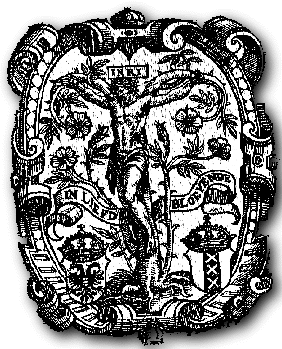 |
The Cnape or doorman and messenger was
an important Chamber functionary. This person was responsible for
restricting access to the rethorijckerscamer or chamber
hall where the membership met and held their performances or
meals. Chambers, especially the larger orders with elaborate
meeting places, controlled the access of non-members to the
chamber hall. Point 24 of the chamber regulations of the Antwerp
Chamber "Violieren" states that guests at chamber meals
had to be approved by the Chamber's prince or deacon and were
asked to pay a fee. Point 25 charges the Cnape with the
duty of closing the chamber hall's doors at the hour of
performance so that no one could enter after the beginning of a
show.
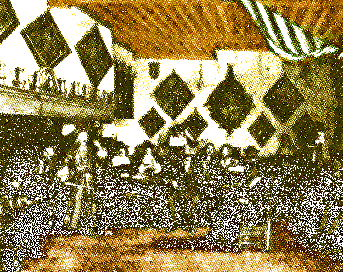 |
|
At regular meetings of the earlier
societies, members read and discussed poetry that they
had written. "De Fontein" the oldest of the
Chambers in Ghent had a regular ritual of literary
competition. The society met every three weeks on a
Sunday afternoon. The Chamber awarded one member a
garland. This person had to produce a refrein
(refrain) within three days. Rederijkers seemed to
greatly favor the refrein as a poetic format. The form
derived from the fourteenth century French ballade.
A refrein consisted of an irregular number of stanzas and
was between eight and twenty-four lines long. Each stanza
had the same last line, which stated the subject of the
poem. The last stanza was as a rule dedicated to the head
of the Chamber and began with the word
"Prince." |
The garland holder's poem was passed to the
membership upon completion. Before the next meeting every member
had to produce another poem on the same model. At the meeting,
the members read their refreins, and the holder of the wreath
gave a prize to the winner. With a celebration and the drinking
of wine, the wreath was passed to another.
Members of the socially ambitious middle
stratum of Dutch urban society perceived membership in a Chamber
and taking part in its proceedings as a respectable social
activity. Writing poetry and plays as well as acting and reciting
as part of membership responsibilities became a popular
occupation for these literate urban Dutch without the pejorative
taint of the esoteric that such creative activities seemed to
carry in other societies at other points in history. The
Rederijkers wrote and performed their material in the language
they spoke (Middle Dutch or Flemish, for instance) unlike
intellectuals like the philosopher Erasmus who wrote in Latin,
the generally accepted international language for serious works,
or courtiers who tended to write in the language of whatever
power was governing the area at that time (such as the
French-speaking Burgundians or German-speaking House of Cleves).
The Chambers served as a vernacular counterpoint to elite French
and Latin culture.

Return to Index
Copyright ©
1997 Kelly S. Taylor






